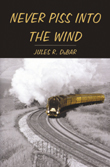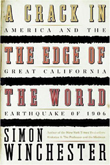 Never
Piss Into the Wind
Never
Piss Into the Windby Jules R. DuBar.
PublishAmerica, 2004.
ISBN 1 4137 1970 8,
Hardcover, $24.95.

Check out this month's On the Web links, your connection to earth science friendly Web sites. The popular Geomedia feature is now available by topic.
Q&A:
Straight from the Source: Simon Winchester: Writing from geology’s front
lines
Print exclusive
Books:
Who said geology had to be boring?:
A review of Never Piss Into the Wind
On shaky ground: A review of A Crack
in the Edge of the World
 Never
Piss Into the Wind Never
Piss Into the Windby Jules R. DuBar. PublishAmerica, 2004. ISBN 1 4137 1970 8, Hardcover, $24.95. |
As an undergraduate student in geology, it was refreshing to get a firsthand
account of what it is like to be a field geologist from Jules DuBar. In his
autobiography Never Piss Into the Wind, DuBar takes a no-holds-barred
look at his long career studying coastal deposition in South Carolina. From
his tales of playing poker with a young field assistant at a local Elks club
to department politics at the University of Houston, the book is one entertaining
vignette after another.
Each tale of heading out to study the coast of the southern United States illustrates
another aspect of working in this field. Everyday living on limited funding
is illustrated through a story in which DuBar explains to his field assistant
that food and lodging is limited to $10 a day in a South Carolina workstation.
Other stories are filled with experiences looking for the ultimate bowl of chili
and beer and dealing with vehicles along back roads. Throughout, DuBar tells
us about his life with humor and, in the process, shows us the varied sides
of geologists.
DuBar’s stories impart what textbooks cannot — the entirely human
aspect of the geological sciences. In his stories of working in the field, the
mayhem, good times and hard work intermingle with rather touchy situations,
such as dealing with the mandates of administrators and with wayward students.
It is clear that an understanding of how to deal with people is imperative to
survival both academically and personally.
While geologists primarily study Earth, studying people could be said to go
hand in hand with their work. It starts with relationships between professors
and students and continues through a career as colleagues and acquaintances
are met along the way. Field exercises and the occasional conference allow for
the opportunity to meet and interact with new people.
For both the geologist and the layperson, DuBar’s book is an absolutely
delightful ramble. For the student geologist, the book is a relaxing read that
begs the question: “Is my chair going to break from my laughing so hard?”
For the nongeologist or later-career geologist, the book introduces one remarkable
personality that some would call colorful, to say the least.
Anyone who enjoys hearing a good tale and who thinks that a scientist has a
boring life or just hides in a room and looks at samples will benefit from this
book. Never Piss Into the Wind requires little knowledge of geology to
understand the basis of the story — only an interest in understanding humanity.
 A
Crack in the Edge of the World: America and the Great California Earthquake
of 1906 A
Crack in the Edge of the World: America and the Great California Earthquake
of 1906 by Simon Winchester Harper Collins, October 2005. ISBN-10: 0 0605 7199 3. Hardcover, $26.95 |
When Simon Winchester sets out to describe something, his story is almost as
complete as the Oxford English Dictionary (OED). His new book, A Crack
in the Edge of the World, seems to describes the Great Earthquake of 1906
that devastated San Francisco as completely as possible. Sometimes that burden
of facts — from tidbits to necessary theories — becomes overwhelming.
Winchester has described in great detail the intricate historical circumstances
of a great many things, from the creation of the OED in his book The Professor
and the Madman to the eruption of Krakatoa in his book of the same name
(see story, page 52). As a geologist and writer, I enjoyed
reading Winchester’s The Map That Changed the World, his biography
of William Smith and “modern geology,” and I found the OED history
quite entertaining — but that may be because I’m not a lexicographer.
Crack is essentially a history of the world, of humans and of geology, and finally
of the Great Earthquake. Winchester rightly situates the beginnings of what
he calls the New Geology, based on plate tectonics and present-day understanding,
with the 1906 event.
If you are a geologist and a closet historian, reading Winchester’s book
on the San Andreas Fault, and the earthquake, can be fun for the cultural history
he provides (a lot was happening in 1906, following on the heels of Einstein’s
groundbreaking physics papers to Freud’s Interpretation of Dreams).
If you are not a geologist, the geology descriptions will be more fun than textbook
reading. Still, I have a hard time deciding whether or not Winchester’s
geology lessons would help or hinder a lay reader. Sometimes, too much jargon
makes them seem as though they would be difficult (Winchester is a geologist
by training), and sometimes, his poetic descriptions seem to take too much literary
license to the point that they would make no sense to an average reader.
Winchester’s stories can be like Gobstoppers: concentric rings of ideas,
events, people’s lives — everything but the topic that he purports
to describe until hundreds of pages into the book, and by then the candy center
may be slightly disappointing. Crack began to feel a bit tedious after awhile.
When I finally got to the earthquake, I felt slightly teased by all the little
details Winchester used to set up the state of San Francisco in 1906. Did you
know that Sun Yat-sen, writer of China’s post-revolutionary constitution
lived in San Francisco’s Chinatown? Or that “hoodlum” was coined
in San Francisco? Neither did I, and I’m not sure I wanted to, but Winchester
somehow ties it all into the San Andreas Fault. Even Meteor Crater in Arizona
makes it into this book.
Still, Winchester hits everything important, even if it is a bit muddled: the
Chinese immigration wave and subsequent xenophobia in San Francisco that led
to discrimination and disaster in Chinatown after the quake; the hodge podge
(or gallimaufry, to use a Winchesterism) of development during the Gold Rush
that led to faulty water and gas lines that contributed to the Great Fire; and,
of course, the orientations of the continents through time, from Pangea and
Gondwanaland to the less familiar Kenorland.
Winchester also describes some current science. The San Andreas Fault Observatory
at Depth (SAFOD) and the Dec. 26, 2004, tsunami get good play. Although the
book was completed before the SAFOD drill crossed the fault (see Geotimes
Web Extra, Aug. 12, 2005), Winchester does an interesting profile of the
project.
If Crack is the only book you read about San Francisco’s earthquake, you
might walk away not wanting to read more. But now that the 100th anniversary
of the Great Quake is almost upon us, it may be worth revisiting Bruce Bolt’s
book on Earthquakes and Geological Discovery, or Michael Collier’s
A Land in Motion, or from a historian’s perspective, an out-of-print
tome called Denial of Disaster that contains original research on how
the fire outshone the earthquake, so to speak, and how people perceived the
destruction of San Francisco.
I highly recommend A Dangerous Place: California’s Unsettling Fate,
by Marc Reisner, the author of Cadillac Desert, published posthumously
in 2003, in which he imagines the Big One striking San Francisco today. Also
try Thurston Clarke’s California Fault: Searching for the Spirit of
a State Along the San Andreas, published in 1997, for an interesting tour
of the places and people shaped by California’s tectonic setting.
Winchester’s own tour of the San Andreas Fault is essentially a journey
through America, from the beginning of geologic time to the present, with some
important events highlighted from the early 1900s. The meat of the book is framed
by a vague travelog of Winchester’s journey through a foreign country (he
is British, and some of his judgments of small-town America, for example, can
be rather harsh), on his way to describing the San Andreas Fault. And although
Crack might be boring and frustrating at times, the payoff of Winchester’s
descriptions of the Great Earthquake is worth sticking it out.
 |
Geotimes Home | AGI Home | Information Services | Geoscience Education | Public Policy | Programs | Publications | Careers |